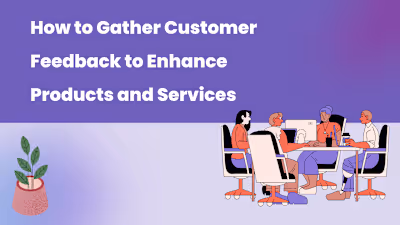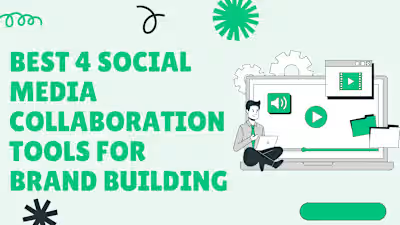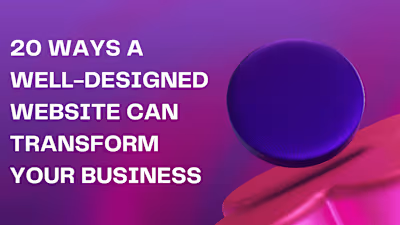A Guide to SaaS Customer Retention with 8 Actionable Strategies
Imagine a scenario where customers become brand advocates, eagerly spreading the word to their family and friends.
Your customer acquisition cost is low, and profit is high. You’re getting more qualified leads filling your pipeline without burning cash to run ads to bring in leads.
Isn’t that amazing?
This is the essence of customer retention, an unwavering commitment to nurturing your existing customer base until they become loyal to your brand.
This article will discuss customer retention, benefits, strategies, metrics, and inspiring examples to drive sustainable growth.
What is customer retention?
Customer retention refers to a company's ability to keep its existing customers engaged and encourage them to make repeat purchases without losing them to competitors.
Implementing customer retention strategies is crucial for business success and directly impacts profitability, longevity, and sustainability. In general, a higher retention rate means that a company is losing fewer customers and keeping more of them, which shows that the business is successful.
Building a solid foundation for customer retention involves creating awareness, delivering valuable content, addressing customer pain points, and showcasing the product's benefits.
Why is customer retention important for SaaS companies?
It’s not news that retaining existing customers is cheaper than acquiring new ones. In their study, Invesp found that existing customers have a 70% chance of renewing their subscription, whereas new prospects have only a 20% likelihood of converting into customers.
Customer retention is crucial for these reasons:
Retaining customers is more cost-effective than acquiring new ones, as it avoids spending on initial acquisition costs for existing customers. Acquiring new customers can be 5x to 25x more expensive than retaining existing ones.
Customer retention yields a higher return on investment than acquiring new customers. Satisfied customers tend to make repeat purchases, resulting in long-term relationships and revenue surpassing initial acquisition costs.
Prioritizing customer retention nurtures customer loyalty, leading to solid commitment and dedication to the brand. Loyal customers remain dedicated to their purchases despite competition or pricing changes and can become valuable brand advocates.
Retained customers are more likely to refer the business to their social circles, generating valuable referrals with higher conversion rates and longer customer lifetime value.
Customer loyalty vs. Customer retention
Although interconnected, customer retention and loyalty have distinct meanings and implications in the SaaS industry.
Customer loyalty refers to the extent to which customers are inclined to engage in repeat business with a specific company or brand. Meanwhile, retention focuses on stability and revenue generation, while loyalty represents deeper engagement and dedication.
Customer retention also lowers acquisition costs and boosts customer lifetime value, while loyalty establishes a foundation for sustainable growth and a competitive edge.
Despite their differences, customer retention and loyalty share similarities. Both are crucial for business success. Both strategies involve customers making repeat purchases, often resulting from positive customer experiences. Additionally, both contribute to value creation for a business, paving the way for long-term success.
Customer Retention Strategies
Losing a customer wastes seven times the resources used in acquiring them. To address this issue, here are eight effective customer retention strategies:
Understand Your Customer Journey
The customer journey refers to the sequential stages of a customer's experience while interacting with your business, from brand discovery to post-purchase engagements. To understand the customer’s journey, the first step is to perform thorough market research. Collect information on their preferences, needs, pain points, location, demographics, etc.
Segment each customer type according to their preferences and create a buyer persona for each segment. With the data collected, create a customer journey map from pre-purchase to post-purchase. Note the touchpoints, areas of high friction, and areas of high drop-off where necessary improvements can be made.
By understanding your customer’s journey, you can pinpoint pain points and provide the necessary support to nurture long-term loyalty and drive customer retention
2. Optimize Customer Onboarding
A seamless, contextual, and personalized customer onboarding experience establishes a strong foundation for retention. This is true, as over 76% of customers will continue engaging with a product after an amazing onboarding experience. However, poor onboarding leads to a 40–60% user drop-off rate after a new user signs up to use your product.
Your customer’s first impression of your product goes a long way. If they find it easy to use and navigate, they stick around and engage more. Otherwise, they bounce.
Start customer onboarding when a new customer signs up for your product. A product tour can work well, but a more efficient way is to implement an interactive walkthrough. Let new users learn at their own pace as they walk through your product.
Use UI elements like tooltips, hotspots, popups, slideouts, or checklists to deliver personalized assistance to customers. For example, tooltips can provide contextual help when users use a new feature. Welcome screens can also be used to collect more information about new users. You can also include tutorial videos to help users.
Create a self-service onboarding process with comprehensive documentation to provide proactive customer support to address their inquiries and Concerns. Consider reaching out when customers cross new milestones and offering one-on-one meetings to understand their desired outcomes.
Implement automation tools and features like automated email sequences, interactive tutorials, and on-screen prompts to optimize onboarding. This streamlines users’ progress, reduces the need for manual intervention, and enhances the overall onboarding experience.
3. Implement a personalized Customer loyalty program.
SaaS companies can create loyalty programs and offer incentives to encourage more customers to spread the word about their products. Segment customers based on individual preferences, purchasing history, or engagement levels. It includes referral programs with incentives for referring and new customers. tiered membership levels with exclusive rewards, and gamification elements to motivate customer interaction and earn incentives.
Personalized rewards in SaaS businesses foster loyalty, create exclusivity, and enhance customer retention by improving the customer experience and nurturing long-term relationships.
4. Provide a fast, excellent customer support system
Exceptional customer service is critical to cultivating valuable customer relationships. SaaS businesses should answer these questions to deliver stellar customer service.
Is the support provided to customers prompt and responsive?
Is the assistance provided to customers proactive and personalized?
Does the customer service team possess adequate knowledge and training?
Do customer service interactions reveal any recurring issues or joint pain points?
Can we implement self-service options and automation?
Is there effective communication between the customer service team and customers?
Do customers express satisfaction with the resolution of their issues?
Investing in training, fostering a customer-centric culture, actively listening to feedback, personalizing the experience, and optimizing processes enhance customer service and drive satisfaction and retention
5. Implement a Customer Feedback Loop
Customer feedback is important for enhancing customer retention and engagement. It provides valuable insights, addresses customer preferences, and highlights areas for improvement in products or services.
The customer feedback loop continuously incorporates user reviews, opinions, and suggestions to improve the customer journey. SaaS companies should utilize surveys, support tickets, interviews, customer reviews, and ratings to ensure a user-friendly and convenient feedback collection process.
Establishing a regular cadence for requesting feedback rather than relying on one-off requests is essential.
Also, assuring customers of confidential and anonymous treatment of their feedback, if desired, helps create a safe space for openly sharing opinions.
Good to know: Companies need a clear plan, resource allocation, open-mindedness, collaboration, and analysis to implement the survey feedback. Prioritizing the customer and creating an effective feedback loop drives innovation, improves retention, and keeps the customer at the forefront.
6. Personalize Customer Interactions
Personalized customer service entails recognizing and addressing individual customer needs, preferences, and interactions with your business to deliver tailored support and experiences.
How, then, do you provide personalized customer service?
SaaS companies should maintain detailed customer information to personalize assistance by tracking purchase history, preferences, and support interactions.
Equip the support team with training, tools, and skills for delivering personalized service through active listening, empathy, and effective problem-solving.
Offer self-service resources such as knowledge bases and FAQs for customers to find answers and troubleshoot independently.
Provide diverse communication channels: phone, email, live chat, and social media.
Proactively predict and personalize suggestions, updates, and offers.
How can B2B companies achieve a harmonious equilibrium between personalized customer service and avoiding the perception of being overly intrusive?
Obtain consent for data collection and provide transparent privacy policies that allow customers to control their information.
Offering opt-in options respects customer autonomy. It allows them to control the level of personalization they desire, ensuring tailored experiences without being perceived as intrusive.
Regularly seeking feedback and listening to customer concerns helps maintain the equilibrium between personalization and intrusiveness.
7. Establish a robust online presence.
Social media is the preferred platform for instant and personalized customer service. It allows for swift resolution of support issues and creates a cohesive customer experience.
Understanding social media platforms, demographics, and their alignment with the customer journey helps improve customer retention.
Active engagement with customers on social media fosters more substantial relationships, prompt issue resolution, and personalized support, increasing customer satisfaction and loyalty.
Use social media to share valuable content, promotions, and exclusive offers. Hence, enhancing customer engagement and loyalty.
Good to know: Creating social media groups or communities further promotes a sense of belonging and allows customer connection, shared experiences, and mutual support, bolstering customer relationships.
8. Continuous improvement using Customer Retention Metrics
Continuous enhancement of products, services, and customer experiences enables businesses to effectively meet customer needs and expectations.
Customer retention metrics provide measurable and actionable insights into customer behavior, loyalty, and satisfaction. These metrics help businesses assess the effectiveness of their systems, monitor progress over time, identify trends, and make data-driven decisions to enhance customer retention.
Customer retention metrics are:
Customer retention rate(CRR)
The customer retention rate refers to the proportion of customers that a business retains over a specific period. The formula is:
Customer Retention Rate = ((E - N) / S) x 100
Where:
E = number of customers at the end of the period
N = Total of customers secured during the period
S = number of customers at the start of the period
For example, if a company starts with 1000 customers, acquires 200 new customers, and ends the month with 900 customers, the customer retention rate is calculated as ((900 - 200) / 1000) * 100 = 70%.
In this case, the customer retention rate is 70%, indicating a 70% retention of the initial customer base during the period.
Customer churn rate(CCR)
Customer churn rate quantifies the percentage or rate of customer attrition.- i.e., the rate customers discontinue their relationship with a company. The formula is:
Customer Churn Rate = (L / S) * 100
Where:
L = number of customers lost.
S = number of customers at the start
For example, if a company starts with 450 customers and loses 50 customers by the end of the month, the customer churn rate would be:
(50 / 450) * 100 = 11.1
That month, 11.1% of the company's customer base was not retained, resulting in a churn rate of 11.1%.
Customer Lifetime Value
Customer lifetime value (CLV) is a metric that measures the total revenue expected from a customer over their entire relationship. The formula is:
CLV = AOV * ANP * ACL
Where
AOV represents the Average Order Value
ANP represents the Average number of purchases
ACL means the mean customer life span.
For instance, if a customer has a typical average purchase amount of $550, makes three purchases per year, and remains active for three years, the CLV would be $4950
A higher CLV indicates better performance, and an increasing CLV over time signifies improved customer retention.
Customer Effort Score (CES)
Customer Effort Score (CES) quantifies the customer's perception of the difficulty or ease of interacting with a company. It is calculated by dividing the total scores by the number of respondents and options and multiplying it by 100.
For example, if a CES survey with 100 respondents results in a total score of 400, the CES would be 80.
Higher Customer Effort Scores (CES) indicate elevated perceived effort levels, while lower scores reflect a seamless experience.
Customer Satisfaction Score(CSS)
A customer satisfaction score (CSAT) is a metric that measures the satisfaction and fulfillment customers derive from engaging with a brand. The formula is:
Customer satisfaction score = (Total positive scores / Number of respondents) x 100
For example, if a CSAT survey with 300 respondents has a total positive score of 1000, the CSAT would be 330.
CSAT = (1000 / 300) x 100
= 3.3 x 100
=330
It indicates a moderate level of customer satisfaction. A higher CSAT score reflects increased customer contentment.
Conclusion
toPrioritize customer retention for lasting relationships, loyalty, and sustainable growth. Build unbreakable bonds, engage your customer base, and unlock the potential for long-term success. Take action now and maximize the value of customer retention in propel your business forward.
Like this project
Posted Jun 3, 2024
A guide to customer retention to build lasting customer relationships, reduce costs, and boost loyalty for sustainable growth and increased profitability.
Likes
0
Views
34





